Northern Virginia Data Center Market Size
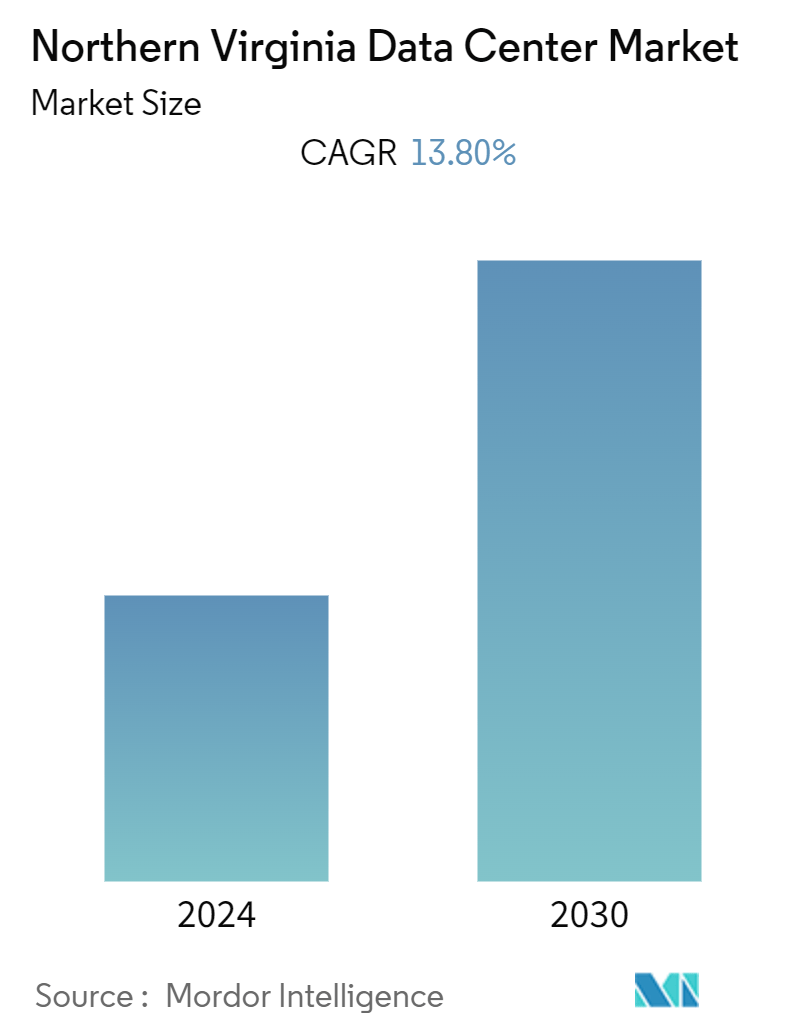
| Study Period | 2019 - 2029 |
| Base Year For Estimation | 2023 |
| Forecast Data Period | 2024 - 2029 |
| Historical Data Period | 2019 - 2022 |
| CAGR (2024 - 2030) | 13.80 % |
| Market Concentration | Low |
Major Players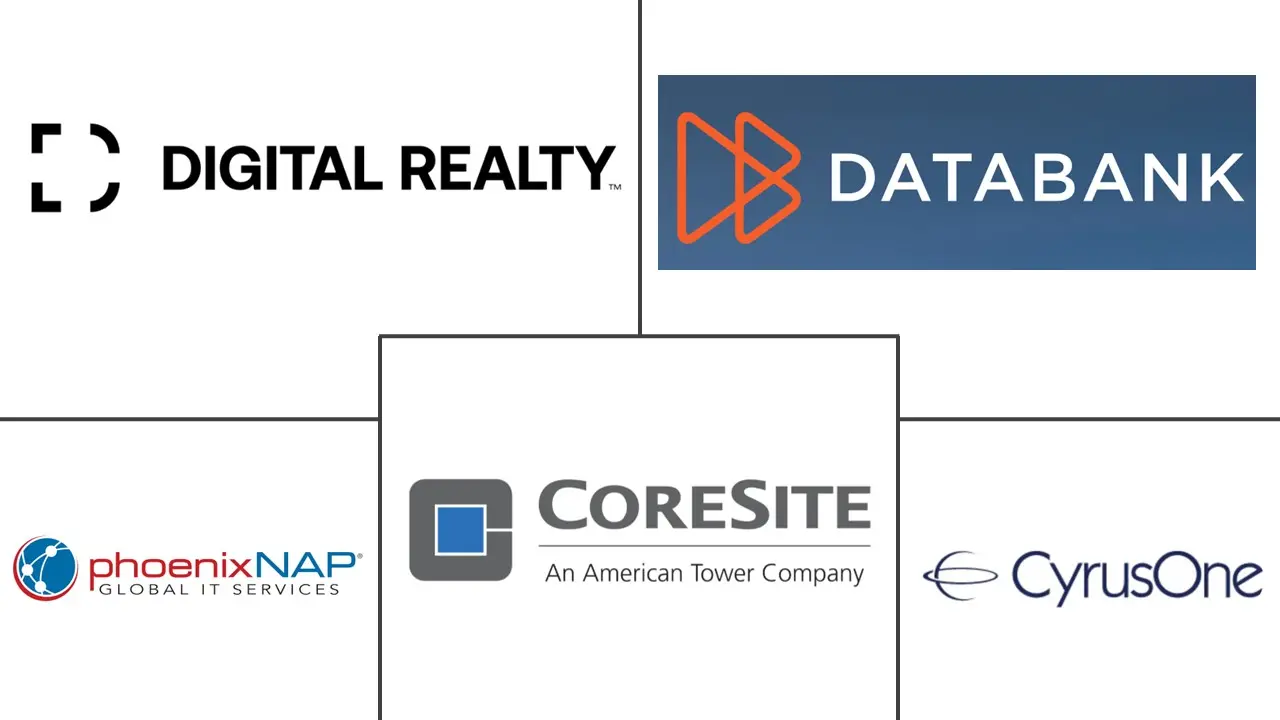
*Disclaimer: Major Players sorted in no particular order |
Northern Virginia Data Center Market Analysis
The Northern Virginia Data Center Market is expected to register a CAGR of 13.80% during the forecast period.
The main drivers anticipated to drive the market expansion are the increasing demand for energy-efficient data centers, considerable investment by colocation service and managed service providers, and expanding hyperscale data center building. Additionally, the development of big data, cloud computing, and the Internet of Things (IoT) made it possible for businesses to invest in new data centers to preserve business continuity.
- Additionally, industrial development is expected to prosper due to the rising need for security, operational efficiency, improved mobility, and bandwidth. Software-based data centers boost industry growth by providing a higher level of automation.
- Artificial intelligence (AI) with machine learning (ML) necessitates the development of brand-new data center infrastructure more than any other application. Artificial intelligence (AI) and machine learning (ML) may require three times the power density of traditional data processing, necessitating a revolution in data center architecture. This is also dependent on sophisticated cooling systems to support the larger output. The intense nature of AI and ML computations may also result in a significant dispersion of computational, memory, and storage resources among many processors in a computational cluster.
- According to a National Parks Conservation Association poll of Northern Virginia residents, most oppose building data centers near public land, including national parks. The survey included 300 respondents from several Northern Virginia jurisdictions. 77% of those polled preferred that municipalities keep present zoning restrictions rather than change them to facilitate construction near parks. Meanwhile, 86% agreed that data centers should be prohibited within a mile of a national park, state park, or historically significant location. Furthermore, 96% agreed that political officials should take a strong stand in support of protecting Virginia's national parks from the impacts of data centers.
- A data center must adhere to the following specification to be defined as a Tier III facility. The facility should offer N+1 (the amount required for operation plus a backup) fault tolerance. Also, the Tier III facility providers can undergo routine maintenance without a hiccup in the overall operations. However, unplanned maintenance and emergencies may cause problems affecting the system. These problems could affect customer-facing operations. These data center facilities provide a 99.982% uptime.
- The companies using these Tier III facilities are often growing companies or businesses that are considerably larger than the average SMBs (Small to Medium Businesses). These Tier III facilities also offer most of the features of a Tier IV infrastructure facility without some elite protection. For instance, enterprises can leverage the advantage of dual power sources and redundant cooling as the network streams are fully backed up.
- On the flip side, the country's commercial real estate has been constantly evolving and changing due to the continued integration of technology at all levels of the industry and across all property types. As more companies have been transitioning toward cloud computing with major vendors expanding their capacities has been influencing land prices; for instance, Amazon Web Services (AWS) currently has cloud infrastructure in 22 regions and has predicted that new data centers may be needed in hundreds of regions to keep up with demand.
Northern Virginia Data Center Market Trends
Tier 4 is Expected to Hold Significant Share of the Market
- A Tier-IV data center represents the other end of the range. This tier promises its customers uptime, 2N (two times the quantity needed for operation) cooling, and redundant infrastructure and electricity. These rules could safeguard most companies. Level IV customers hardly ever learn about problems with the data center infrastructures because of these redundancies. These tests serve as a testament to the dependability of top-tier systems.
- Several independent and physically separate systems act as redundant capacity components and distribution routes in this data center. Separation is necessary to avoid harm from being done to both procedures by a single event. Unexpected or planned disturbances may not have an impact on the ecosystem. The environment may be more susceptible to disruption if a failure happens if redundant components or distribution pathways are closed for repair.
- Tier-IV data centers are called "fault-tolerant." Unplanned maintenance does not affect data flow to a Tier-IV data center. Day-to-day operations continue regardless of whether or not assistance is provided. Mega companies frequently select Tier-IV data centers, outperforming all three tiers outlined above. The uptime rates can reach 99.995%, implying that the data center may only have 0.5 hours of downtime annually. A Tier-IV data center also has 96-hour power outage protection and multiple redundancies to ensure the system can continue operating even if significant components fail.
- Tier-IV facilities increase the failure tolerance of the Tier-III topology. IT operations will be unaffected if equipment fails or the distribution path is disrupted. All IT equipment must have a fault-tolerant power design to be interoperable. Continuous cooling is also required in Tier-IV data centers to maintain a stable environment. While the redundancy required to operate and maintain a Tier-IV data center is frequently prohibitively expensive, companies with the resources to reap the benefits of improved performance and dependability do so without hesitation. Government agencies often operate their data centers by Tier-IV data center standards.
- According to SurfShark, In 2022, the United States E-infrastructure index amounted to 0.1944. By contrast, the Internet affordability index was only 0.0326. Depending on their location, fewer mega data centers may enable a corporation to take advantage of local advantages such as tax breaks, low energy prices, favorable weather, or alternative energy sources. As a result, the mega data centers result from cost-cutting efforts aimed at increasing profit. Such developments have the potential to propel market growth in the coming years.
- One of the primary drivers driving demand for data center systems and technology, propelling the market growth, is the rising cloud technology in data centers. Cloud technology is more adaptable because it can be accessed from various devices, and data may be recovered quickly. On the other hand, cloud computing provides fast speed, which aids the growth of other firms.
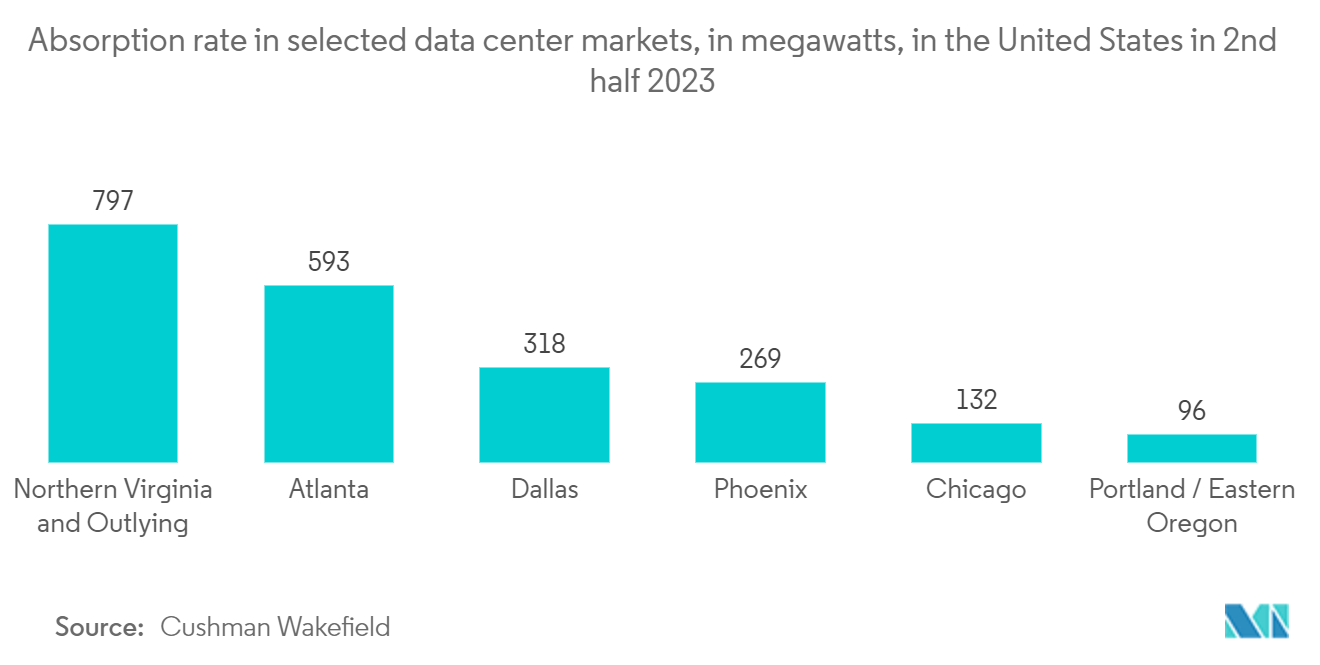
BFSI Segment is Expected to Hold a Significant Share of the Market
- The BFSI industry has been one of the most influenced by enterprises' digital transformation, allowing for more cost-effective revenues. The rising Northern Virginia adoption of mobile phones and high-speed internet has pushed individuals to choose digital banking, which has also integrated robust CRM and cloud technologies to store and analyze data, which is projected to boost the market growth.
- The rapid expansion of electronic banking, digital storage, and virtualization in the BFSI sector will likely drive demand for cost-effective and energy-efficient data center solutions. It enables the consistent and reliable availability of IT and digital banking services in a highly protected environment. It can also connect and encrypt all device communications while controlling user access to protect against errors and bad intent.
- Moreover, banks and insurance companies must reinvent themselves due to changing regulations, emerging technology, elevated client expectations, and the entry of disruptive competitors. In the fintech industry, online lending has increased in city demand. Thus, online banking will become more popular each year, and it is expected to increase the demand for resilient, safe, cost-effective, and energy-efficient data center solutions, driving the need for data center construction. According to FDIC, In 2022, there were 4,135 FDIC-insured commercial banks in the United States.
- Furthermore, advances in digitization, such as the introduction of PSD2 and robust e-commerce growth, would likely pave the way for the development of numerous new payment methods. A growing range of payment methods, including Apple Pay, Google Pay, RatePAY, Amazon Pay, and many more expected to boost the rise of digital payments. This is predicted to generate a massive amount of data, increasing the demand for cloud adoption and, in turn, increasing the need for data center building around the city.
- The digital ecosystem surrounding a bank is exploding at a rapid pace. With the constant change in demand of consumers, there has been pressure on the banks to customize the product offerings according to their needs. Secondly, consumers who embrace a mobile lifestyle and socialize on digital platforms expect banks to connect with them on the same media. This is affecting the demand for the construction of data centers in the BFSI sector.
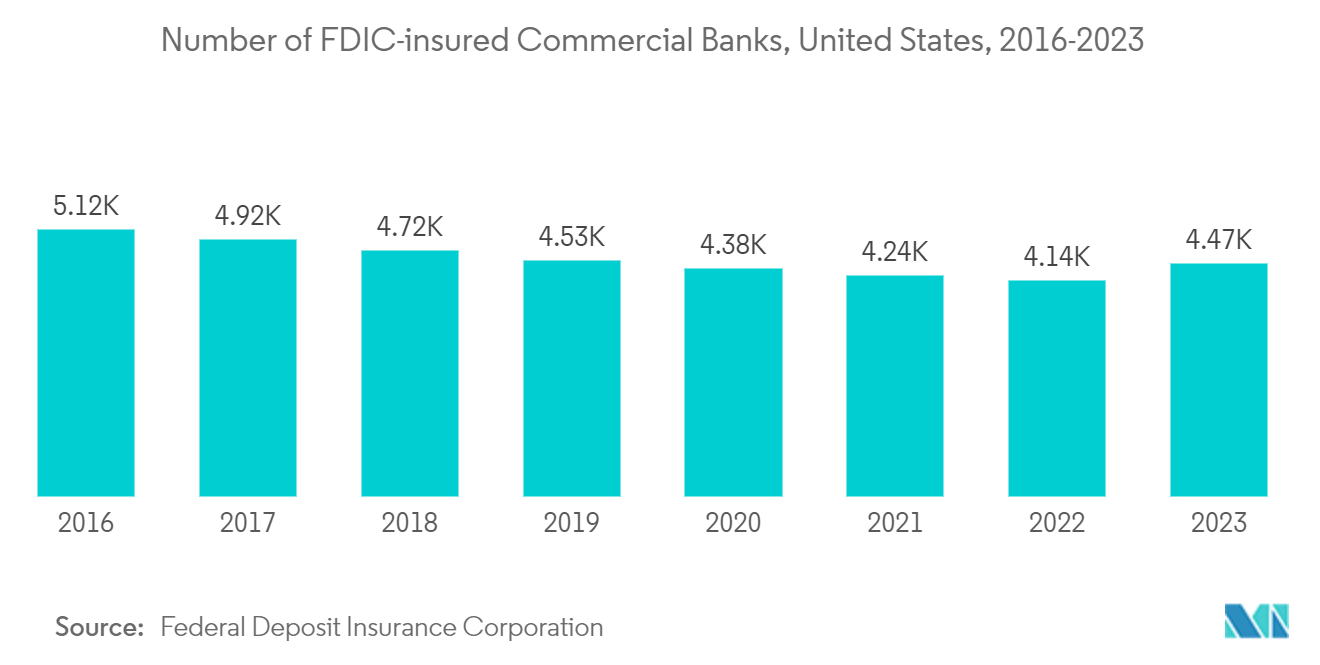
Northern Virginia Data Center Industry Overview
The Northern Virginia Data Center market is fragmented with major players like Digital Realty Trust, Inc., DataBank, PhoenixNAP, CoreSiteetc, etc. The companies continuously invest in strategic partnerships and product developments to gain substantial market share.
In April 2023, The Peterson Company proposes a USD 1.5 billion Northern Virginia Data Centre Campus. According to Potomac Local and Data Centre Dynamics, the proposed 524-acre site may eventually accommodate more than two dozen distinct structures on an undeveloped expanse of woodlands near Stafford Regional Airport. According to county planning officials, Peterson affiliate Stafford Technology LC expects to invest more than USD 1.5 billion in developing the Stafford Technology Campus.
In March 2023, EdgeCoreDigital Infrastructure, a wholesale data center developer, owner, and operator, announced the expansion of its Northern Virginia presence through the formation of a partnership with Penzance, a Washington, D.C.-based real estate developer, to co-develop 7.6 acres in the heart of the world's largest data center market. Customers desiring high-performance capacity with low-latency access to crucial cloud hubs and network connections throughout Northern Virginia can use the location.
Northern Virginia Data Center Market Leaders
-
Digital Realty Trust, Inc.
-
DataBank
-
PhoenixNAP
-
CoreSite
-
CyrusOne
-
Equinix Inc.
*Disclaimer: Major Players sorted in no particular order
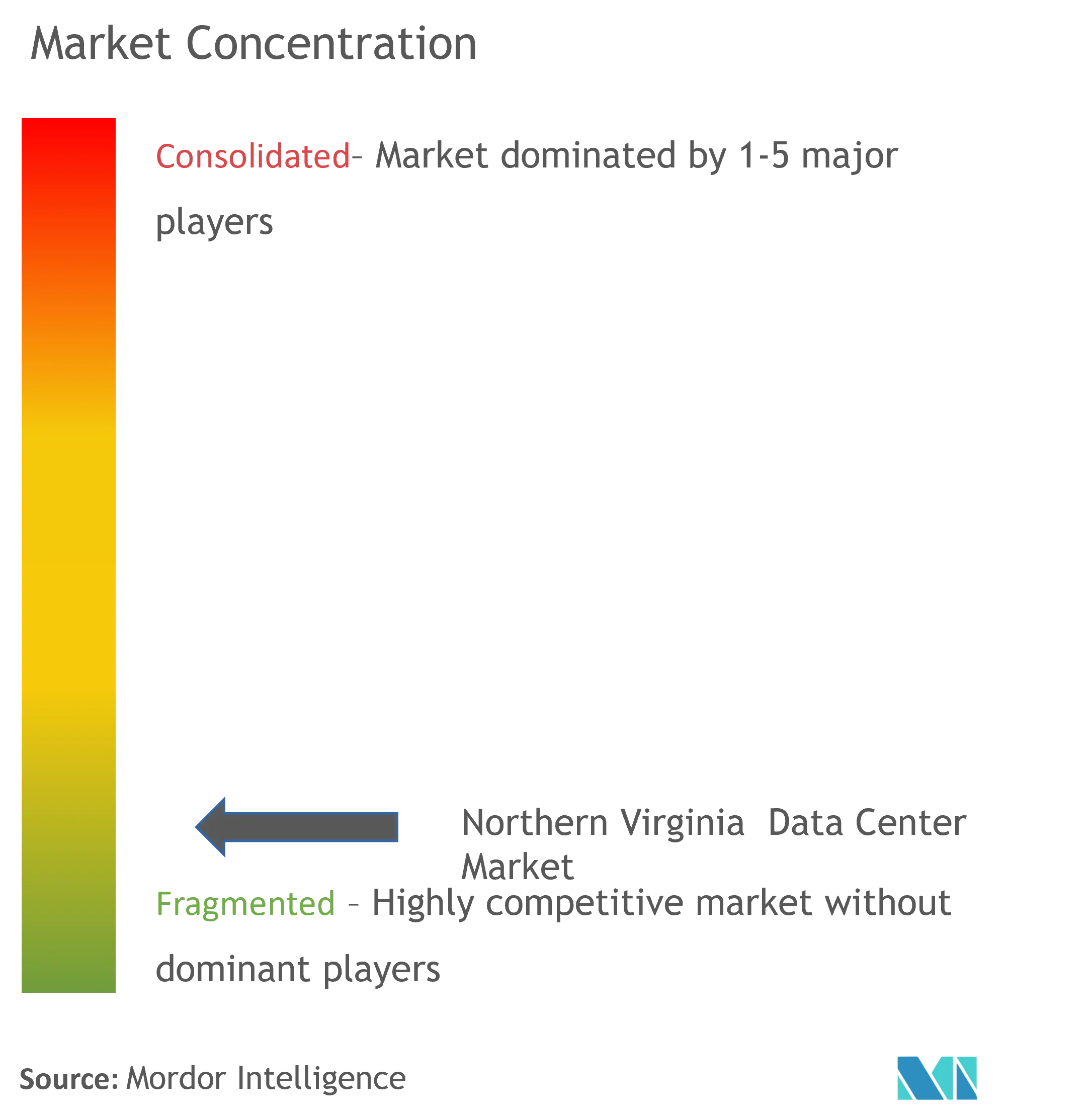
Northern Virginia Data Center Market News
- May 2023: Culpeper County, Virginia, may soon see the building of more than four million square feet of data centers. The Culpeper Town and County Councils have received rezoning proposals allowing the construction of about 17 structures on two campuses on the town's border alongside McDevitt Drive. According to the Culpeper Star-Exponent, the Culpeper County Planning Commission voted 7-1 last week to approve an application to rezone approximately 34.4 acres from RA (Rural Areas) to LI (Light Industrial) over Route 799 (McDevitt Drive) and Route 699 (East Chandler Street) in the StevensburgMagisterial area.
- April 2023: GI Partners, a renowned private alternative investment group, announced the acquisition of 43915 Devin ShafronDrive in Ashburn, Virginia, as part of its ongoing strategy of acquiring and managing technology-enabled real estate. The complex is on a 98-acre campus maintained by one of the world's premier data center operators. Since its initial construction in 2010, the property has been institutionally maintained and is 100% leased to two creditworthy tenants. The property provides 9 MW of vital power and has the potential to grow in the future. The facility offers redundant electrical and mechanical upgrades and several connectivity possibilities via the neighboring campus.
Northern Virginia Data Center Market Report - Table of Contents
1. INTRODUCTION
- 1.1 Study Assumptions and Market Definition
- 1.2 Scope of the Study
2. RESEARCH METHODOLOGY
3. EXECUTIVE SUMMARY
4. KEY INDUSTRY TRENDS
- 4.1 Smartphone Users
- 4.2 Data Traffic per Smartphone
- 4.3 Mobile Data Speed
- 4.4 Broadband Data Speed
- 4.5 Regulatory Framework
- 4.6 Value Chain Analysis
5. MARKET OUTLOOK
- 5.1 IT Load Capacity
- 5.2 Raised Floor Space
- 5.3 Number of Racks
6. MARKET SEGMENTATION
-
6.1 DC Size
- 6.1.1 Small
- 6.1.2 Medium
- 6.1.3 Large
- 6.1.4 Massive
- 6.1.5 Mega
-
6.2 Tier Type
- 6.2.1 Tier 1 & 2
- 6.2.2 Tier 3
- 6.2.3 Tier 4
-
6.3 Absorption
- 6.3.1 Utilized
- 6.3.1.1 Colocation Type
- 6.3.1.1.1 Retail
- 6.3.1.1.2 Wholesale
- 6.3.1.1.3 Hyperscale
- 6.3.1.2 End User
- 6.3.1.2.1 Cloud & IT
- 6.3.1.2.2 Telecom
- 6.3.1.2.3 Media & Entertainment
- 6.3.1.2.4 Government
- 6.3.1.2.5 BFSI
- 6.3.1.2.6 Manufacturing
- 6.3.1.2.7 E-Commerce
- 6.3.1.2.8 Other End User
- 6.3.2 Non-Utilized
7. COMPETITVE LANDSCAPE
-
7.1 Company Profiles*
- 7.1.1 Digital Realty Trust, Inc.
- 7.1.2 DataBank
- 7.1.3 PhoenixNAP
- 7.1.4 CoreSite
- 7.1.5 CyrusOne
- 7.1.6 Equinix Inc.
- 7.1.7 Vantage Data Center
- 7.1.8 Iron Mountain
- 7.1.9 Cyxtera Technologies, Inc.
- 7.1.10 NTT Ltd
- 7.1.11 Rackspace Technology
- 7.1.12 Evocative
- 7.1.13 Flexential
- 7.1.14 Evoque
- 7.1.15 H5 Data centers
- 7.1.16 Quality Technology Services
- 7.1.17 365 data centers
- 7.1.18 Stack Infrastructure
- 7.1.19 Cogent
- 7.1.20 Cologix
- 7.1.21 EdgeCore
- 7.1.22 EdgeConneX, Inc.
- 7.2 Market share analysis (In terms of MW)
- 7.3 List of Companies
Northern Virginia Data Center Industry Segmentation
A data center is a physical room, building, or facility that holds IT infrastructure used to construct, run, and provide applications and services and store and manage the data connected with those applications and services.
The Northern Virginia data center market is segmented by dc size (small, medium, large, massive, mega), tier type (tier 1&2, tier 3, tier 4), absorption (utilized (colocation type (retail, wholesale, hyperscale), end user (cloud & IT, telecom, media & entertainment, government, BFSI, manufacturing, e-commerce)), and non-utilized).
The market sizes and forecasts are provided in terms of volume (MW) for all the above segments.
| DC Size | Small | ||
| Medium | |||
| Large | |||
| Massive | |||
| Mega | |||
| Tier Type | Tier 1 & 2 | ||
| Tier 3 | |||
| Tier 4 | |||
| Absorption | Utilized | Colocation Type | Retail |
| Wholesale | |||
| Hyperscale | |||
| Absorption | Utilized | End User | Cloud & IT |
| Telecom | |||
| Media & Entertainment | |||
| Government | |||
| BFSI | |||
| Manufacturing | |||
| E-Commerce | |||
| Other End User | |||
| Absorption | Non-Utilized |
Northern Virginia Data Center Market Research Faqs
What is the current Northern Virginia Data Center Market size?
The Northern Virginia Data Center Market is projected to register a CAGR of 13.80% during the forecast period (2024-2029)
Who are the key players in Northern Virginia Data Center Market?
Digital Realty Trust, Inc., DataBank, PhoenixNAP, CoreSite, CyrusOne and Equinix Inc. are the major companies operating in the Northern Virginia Data Center Market.
What years does this Northern Virginia Data Center Market cover?
The report covers the Northern Virginia Data Center Market historical market size for years: 2019, 2020, 2021, 2022 and 2023. The report also forecasts the Northern Virginia Data Center Market size for years: 2024, 2025, 2026, 2027, 2028 and 2029.
Northern Virginia Data Center Industry Report
Statistics for the 2024 Northern Virginia Data Center market share, size and revenue growth rate, created by Mordor Intelligence™ Industry Reports. Northern Virginia Data Center analysis includes a market forecast outlook to for 2024 to 2030 and historical overview. Get a sample of this industry analysis as a free report PDF download.



